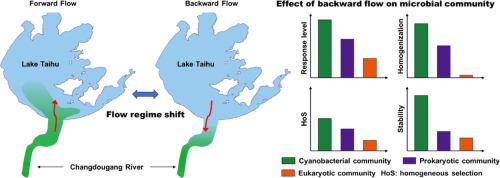当前位置:
X-MOL 学术
›
Water Res.
›
论文详情
Our official English website, www.x-mol.net, welcomes your
feedback! (Note: you will need to create a separate account there.)
Sequential decline in cyanobacterial, total prokaryotic, and eukaryotic responses to backward flow in a river connected to Lake Taihu
Water Research ( IF 11.4 ) Pub Date : 2024-11-12 , DOI: 10.1016/j.watres.2024.122784 Jun Zuo, Siyu Yang, Hans-Peter Grossart, Peng Xiao, He Zhang, Rui Sun, Guoyou Li, Haoran Jiang, Qihang Zhao, Meng Jiao, Yao Cheng, Zeshuang Wang, Ruozhen Geng, Zengling Ma, Renhui Li
Water Research ( IF 11.4 ) Pub Date : 2024-11-12 , DOI: 10.1016/j.watres.2024.122784 Jun Zuo, Siyu Yang, Hans-Peter Grossart, Peng Xiao, He Zhang, Rui Sun, Guoyou Li, Haoran Jiang, Qihang Zhao, Meng Jiao, Yao Cheng, Zeshuang Wang, Ruozhen Geng, Zengling Ma, Renhui Li

|
River ecosystems face escalating challenges due to altered flow regimes from human activities, such as urbanization with hydrological modifications. Understanding the role of microbial communities for ecosystems with changing flow regimes is still incomplete and remains at the frontier of aquatic microbial ecology. In particular, influences of riverine backward flow on the aquatic biota remain largely unknown. Therefore, we examined the impact of backward flow on the cyanobacterial, total prokaryotic, and eukaryotic communities in the Changdougang River, which naturally flows into Lake Taihu, through environmental DNA metabarcoding. We analyzed the differences in community diversity, assembly, and ecological network stability among groups under backward, weak, and forward flow direction conditions. Non-metric multidimensional scaling showed higher variations in communities of groups across flow direction conditions than seasonal groups. Variations in alpha and beta diversity showed that cyanobacterial and total prokaryotic communities experienced strong homogenization under backward flow conditions, whereas the ecological uniqueness of the eukaryotic community decreased. Assembly of the three flow-related communities was primarily governed by drift and dispersal limitation in stochastic processes. However, in the cyanobacterial community, homogeneous selection in deterministic processes increased from 22.79% to 42.86% under backward flow, aligning with trends observed in the checkerboard score (C-score). More importantly, the topological properties of ecological networks and the degree of average variation revealed higher stability in the cyanobacterial community compared to total prokaryotic and eukaryotic communities. Considering the variations in cohesion, the network stability in the cyanobacterial community decreased under backward flow. Our findings emphasize the distinct and sequentially diminishing responses of cyanobacterial, total prokaryotic, and eukaryotic communities to backward flowing rivers. This knowledge is crucial for maintaining ecological health of rivers, assessing the complex ecological impacts on hydrological engineering, and formulating sustainable water management strategies.
中文翻译:

在与太湖相连的河流中,蓝细菌、总原核生物和真核生物对倒流的反应连续下降
由于人类活动(例如水文改造的城市化)改变了水流状况,河流生态系统面临着不断升级的挑战。了解微生物群落对流动状态变化的生态系统的作用仍然不完整,并且仍处于水生微生物生态学的前沿。特别是,河流倒流对水生生物群的影响在很大程度上仍然未知。因此,我们通过环境 DNA 宏条形码研究了倒流对自然流入太湖的长豆港河中蓝细菌、总原核和真核生物群落的影响。我们分析了在后流、弱流和前流方向条件下各类群在群落多样性、组装和生态网络稳定性方面的差异。非度量多维尺度显示,与季节性群体相比,不同流向条件下的群体社区变化更大。α 和 β 多样性的变化表明,蓝细菌和总原核生物群落在逆流条件下经历了强烈的同质化,而真核生物群落的生态独特性降低。三个与流动相关的群落的组装主要受随机过程中漂移和扩散限制的控制。然而,在蓝藻群落中,确定性过程中的同质选择在倒流下从 22.79% 增加到 42.86%,这与棋盘评分 (C-score) 中观察到的趋势一致。更重要的是,与整个原核生物和真核生物群落相比,生态网络的拓扑特性和平均变异程度表明蓝藻群落的稳定性更高。 考虑到内聚力的变化,蓝藻群落中的网络稳定性在反向流动下降低。我们的研究结果强调了蓝细菌、总原核生物和真核生物群落对逆流河流的不同且连续递减的反应。这些知识对于维护河流的生态健康、评估对水文工程的复杂生态影响以及制定可持续的水资源管理策略至关重要。
更新日期:2024-11-13
中文翻译:

在与太湖相连的河流中,蓝细菌、总原核生物和真核生物对倒流的反应连续下降
由于人类活动(例如水文改造的城市化)改变了水流状况,河流生态系统面临着不断升级的挑战。了解微生物群落对流动状态变化的生态系统的作用仍然不完整,并且仍处于水生微生物生态学的前沿。特别是,河流倒流对水生生物群的影响在很大程度上仍然未知。因此,我们通过环境 DNA 宏条形码研究了倒流对自然流入太湖的长豆港河中蓝细菌、总原核和真核生物群落的影响。我们分析了在后流、弱流和前流方向条件下各类群在群落多样性、组装和生态网络稳定性方面的差异。非度量多维尺度显示,与季节性群体相比,不同流向条件下的群体社区变化更大。α 和 β 多样性的变化表明,蓝细菌和总原核生物群落在逆流条件下经历了强烈的同质化,而真核生物群落的生态独特性降低。三个与流动相关的群落的组装主要受随机过程中漂移和扩散限制的控制。然而,在蓝藻群落中,确定性过程中的同质选择在倒流下从 22.79% 增加到 42.86%,这与棋盘评分 (C-score) 中观察到的趋势一致。更重要的是,与整个原核生物和真核生物群落相比,生态网络的拓扑特性和平均变异程度表明蓝藻群落的稳定性更高。 考虑到内聚力的变化,蓝藻群落中的网络稳定性在反向流动下降低。我们的研究结果强调了蓝细菌、总原核生物和真核生物群落对逆流河流的不同且连续递减的反应。这些知识对于维护河流的生态健康、评估对水文工程的复杂生态影响以及制定可持续的水资源管理策略至关重要。


















































 京公网安备 11010802027423号
京公网安备 11010802027423号